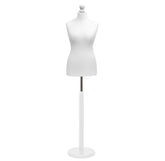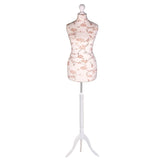Your Guide to Wall Mount Hanging Rail Solutions
At its heart, a wall mount hanging rail is a straightforward and highly effective storage fixture. It attaches directly to a wall, giving you a dedicated place to hang clothing and other items without taking up any floor space. But it’s much more than just a simple metal bar; think of it as a floating storage solution that’s perfect for both modern homes and dynamic retail spaces.
The 'Floating Wardrobe' That Redefines Your Space
The best way to think about a wall mount hanging rail is as a ‘floating wardrobe’. This simple concept perfectly captures its biggest advantage: it lets you tap into vertical space that would otherwise be completely wasted. Instead of a bulky, floor-standing wardrobe hogging half the room, a hanging rail opens everything up, creating a minimalist look while still delivering on practical storage.
This clever approach to organisation does more than just hold your clothes; it completely transforms how a space feels and functions.
More Than Just Storage
A wall mount hanging rail helps you achieve a clean, uncluttered look that's tough to get with traditional furniture. For anyone at home, this could mean turning a cramped bedroom or a narrow hallway into a beautifully organised, airy area. For retailers, it’s a brilliant visual merchandising tool, letting them create eye-catching displays that make specific collections pop without being tied down by fixed floor units.
The beauty of these rails is their versatility. They work brilliantly in all sorts of places:
- At Home: Perfect for creating an open-plan wardrobe in a bedroom, a stylish coat rack in an entryway, or even a handy utility rail in a laundry room.
- In Retail: Gives boutique shops the power to build flexible, high-impact product walls that can be changed in minutes to show off new stock or seasonal trends.
- Creative Uses: You can even see them in kitchens holding pots and pans, in living rooms for hanging plants, or in studios for keeping materials organised and within reach.
This adaptability has made them an incredibly popular choice. The demand for space-saving fixtures is a major trend across Europe, and the UK market for wall mount hanging rails is part of a wider £4-5 billion European sector focused on smart storage. As our living spaces get smaller, this demand is only set to grow. You can discover more insights about the growing demand for wall-mounted clothes rails and see how they are shaping modern interiors.
By lifting storage off the floor, a hanging rail doesn’t just save space—it brings a sense of lightness and order to a room. It’s a simple piece of hardware that makes a huge impact on both how a room works and how it looks, proving its value time and time again.
How to Choose the Right Hanging Rail
Picking the right wall mount hanging rail isn't a one-size-fits-all affair. It's about finding the perfect match for your space, your style, and what you actually plan to hang on it. Think of it like buying a new pair of shoes; you wouldn't wear hiking boots to a black-tie dinner. The same logic applies here.
A sleek, polished chrome rail might look fantastic in a minimalist bedroom, but it would be out of its depth in a busy stockroom. For that, you’d want a rugged industrial steel pipe rail that can handle the daily grind. The process is a bit like choosing cabinet hardware; you're aiming for a seamless blend of function, durability, and a look that complements the rest of the room.
If you're unsure whether a wall-mounted solution is even the best place to start, this quick decision tree can point you in the right direction.

As the infographic shows, when floor space is at a premium, a wall mount hanging rail is often the most practical and efficient way forward.
Getting to Grips with Load Capacity
This is the big one. The load capacity, usually given in kilograms, tells you exactly how much weight the rail can safely hold once it's properly installed. Don't just guess this part. Overloading a rail can lead to it sagging, pulling away from the wall, or worse, failing completely.
To figure out what you need, a little prep work goes a long way. Gather up the clothes you want to hang and get a rough idea of their combined weight. A typical men's suit weighs about 2kg, but a heavy winter coat can easily be 3kg or more. If you plan to hang ten of those heavy coats, you're already looking at over 25kg before you even add anything else. Make sure your rail is up to the task.
It's no surprise that metal rails are so popular, holding a massive 31.5% share of the UK market, largely thanks to their durability and low maintenance. Standard rails can typically handle loads between 25-50 kg, while the heavy-duty versions made from industrial steel pipe can comfortably bear over 60 kg.
Matching Materials and Dimensions to Your Space
The material you choose doesn't just affect the rail's strength and lifespan; it also plays a huge role in its overall look and feel. Each option has its own distinct character, making it a better fit for certain environments.
Choosing the right material is a balance of function and style. This table breaks down the most common options to help you decide.
Hanging Rail Material Comparison
| Material | Typical Load Capacity | Best For | Aesthetic Style | Maintenance |
|---|---|---|---|---|
| Industrial Steel | 50kg - 60kg+ | Heavy commercial use, stockrooms, heavy garment storage | Raw, urban, industrial-chic | Very low; may require occasional dusting. |
| Chrome Finish | 25kg - 40kg | Retail boutiques, modern bedrooms, contemporary displays | Sleek, modern, reflective | Low; wipe with a soft cloth to prevent fingerprints. |
| Powder-Coated Metal | 25kg - 50kg | Home wardrobes, customised retail spaces, children's rooms | Versatile, customisable (black, white, etc.) | Low; durable and resistant to scratching. |
As you can see, your choice of material directly impacts what you can store and the visual statement you want to make.
Of course, the material is only half the story. You also need to get the dimensions right. Start by measuring your available wall space, but remember to leave a bit of breathing room on either side so it doesn't look cramped. A 90cm rail is great for a curated collection or a guest room, whereas a longer 180cm rail might be necessary for a full seasonal wardrobe.
Don't forget to check the depth—that’s how far the rail sticks out from the wall. You need to make sure there's enough clearance for your hangers to move freely without scraping against the wall. To make sure every part of your setup works together perfectly, you can also explore our guide on selecting the right clothing rail brackets.
Installing Your Rail for Maximum Safety
A wall mount hanging rail is only ever as strong as its installation. You can have the sturdiest steel rail in the world, but if it isn't anchored properly, it's not going to do its job. Think of it like a ship's anchor; a mighty anchor is useless if it can't get a solid grip on the seabed. Your rail is the same—it needs the right fixings, drilled securely into a suitable wall, to perform safely and reliably.
Getting this right all starts with one crucial first step: figuring out what your wall is made of. If you skip this, you’re essentially working blind, and even the toughest rail could pull away from the wall under a surprisingly light load. This simple check is the absolute foundation of a safe, long-lasting installation.

Know Your Wall, Know Your Fixings
Different wall materials demand completely different anchoring methods. Trying to use a standard screw in a plasterboard wall, for example, is a recipe for disaster. The material is just too soft and crumbly to offer any real grip.
Here’s a quick rundown of common wall types and the fixings you'll need:
- Plasterboard (Hollow Walls): A common sight in modern buildings. For maximum strength, you must use a stud finder to locate the wooden studs behind the plasterboard and drill directly into them. If there are no studs where you need to hang the rail, you’ll need specialist plasterboard fixings like spring toggles or heavy-duty hollow wall anchors.
- Brick or Concrete (Solid Walls): This is the ideal scenario, offering the strongest foundation. You'll need a masonry drill bit to create a pilot hole, then a sturdy wall plug and a long, heavy-duty screw to create an unshakeable hold.
- Lath and Plaster (Older Homes): These can be tricky, as the old plaster can be brittle and prone to cracking. It's always best to aim for the wooden laths or, even better, the structural studs behind them for a truly secure fit.
Choosing the right fixing isn't optional—it's essential. A properly installed wall mount hanging rail should feel completely rigid when you give it a tug. There should be no movement or give whatsoever. If it wobbles, it’s not safe.
The Essential Installation Process
Once you’ve identified your wall type and gathered the correct fixings, the process itself is quite straightforward. Taking your time here will pay dividends, resulting in a perfectly level and secure rail that you can trust. The principles of secure mounting are universal, and for a deeper dive, you can find some valuable insights in this ultimate guide to shelving bracket installation, which shows how these techniques apply even in unconventional settings.
For a successful installation, just follow these key steps:
- Gather Your Tools: You’ll need a spirit level, tape measure, pencil, a drill with the correct bits for your wall type, and a stud finder if you’re dealing with hollow walls.
- Mark Your Position: Decide on the perfect height for your rail. Use the spirit level to draw a faint, perfectly horizontal line on the wall. Then, hold the rail in position and mark the exact drill points through its brackets.
- Drill with Care: Carefully drill pilot holes at the points you marked. For solid walls, pop in your wall plugs and gently tap them so they sit flush with the wall surface.
- Secure the Rail: Line up the rail with your pilot holes and drive the screws in until they are tight and snug. Before you load it up, give the rail a firm tug to double-check that it is completely secure.
By following these steps, you can install your fixture with confidence. For more detailed tips and a visual walkthrough, be sure to explore our complete article on how to correctly install a hanging rail wall mounted system.
Creative Ways to Use Your Hanging Rail
A wall mount hanging rail is so much more than a place to hang your coats. The minute you start thinking beyond the wardrobe, this simple fixture transforms into a seriously versatile tool for interior design and visual merchandising. It’s an opportunity to solve practical problems in a stylish way, adding character and function to almost any space.
When you reimagine its purpose, a purely functional item can become a standout design feature. This simple shift in thinking allows the humble hanging rail to play a central role in your room's story, whether that's at home or in a retail shop.

Elevating Your Home Interior
At home, a hanging rail can bring both organisation and personality to places you might not expect. Its uses are really only limited by your imagination, offering clever solutions for everyday challenges while lifting your home's overall look.
Think about giving these ideas a try:
- The Entryway Hero: Ditch the bulky coat stand. A sleek wall mount rail creates an instant, minimalist spot for coats. Just add a few stylish S-hooks for bags, scarves, and umbrellas to keep your entrance clean and welcoming.
- The Kitchen Organiser: Mount a rail above your worktop to hang pots, pans, and utensils. This not only frees up precious cupboard space but gives your kitchen a professional, rustic feel, keeping your most-used tools right where you need them.
- The Living Room Display: Use a hanging rail as an unconventional way to display trailing plants, beautiful textiles, or even a collection of curated art prints. It creates a dynamic, layered look that draws the eye and brings a lovely bit of greenery and texture to your walls.
By thinking creatively, the rail becomes a versatile anchor for your decor. It’s a simple, cost-effective way to add a custom touch that reflects your personal style and makes your space work smarter.
Creating Compelling Retail Displays
For any retailer, visual merchandising is everything. A wall mount hanging rail is one of the most adaptable tools you can have. It lets you create compelling feature walls that can be updated in minutes, keeping your displays fresh and engaging for customers.
A well-placed rail can turn a flat, uninspired wall into a boutique-style focal point. You could use it to highlight a new collection, showcase a specific colour story, or put together a "look of the week." This approach doesn't just make your products more visible; it helps tell a story, guiding the customer's eye and creating an inviting atmosphere that encourages them to browse. For more ideas on making the most of your space, check out our guide to clothes rail storage solutions.
The Future of Wall-Mounted Storage
The humble wall-mounted hanging rail is far more than just a bit of hardware; it’s a direct answer to how we live and work today. Its rising popularity isn't a fluke. It's tied to huge lifestyle shifts, like the move towards city living and the growing need for smarter, more flexible spaces in both our homes and shops.
As our cities get more crowded, our living and working areas naturally shrink. This trend has forced us all—homeowners, renters, and designers alike—to start thinking vertically. Solutions that free up precious floor space have become incredibly valuable, and the hanging rail is a perfect example. It offers crucial storage without the bulky footprint of traditional wardrobes or shelving units. It’s a genuinely practical tool for modern life.
Keeping in Step with Modern Design Trends
But it's not just about function. The wall-mounted hanging rail also slots perfectly into some of today's biggest interior design movements. Its clean, simple lines and clear purpose make it a natural choice for minimalism, where every single object has to earn its keep by being both beautiful and useful.
At the same time, its raw, functional look is a cornerstone of the industrial chic style. Think about it: an exposed metal rail mounted against a bare brick or concrete wall isn't just storage. It's a bold design statement that celebrates the honesty of its form and materials. This aesthetic appeal is a huge reason why we're seeing them everywhere, from loft apartments to boutique clothing stores.
The real magic of the hanging rail is its dual identity. It’s a problem-solver and a style-enhancer all in one. It meets the practical demands of modern living while perfectly complementing contemporary design, making it a truly versatile fixture.
Innovation That Follows Our Needs
The way hanging rails are evolving is being guided directly by what people want and need. We're no longer just looking for a place to hang things; we want personalised, flexible systems that can change as our lives do. Market research shows that this growth is set to continue, driven by a bigger focus on interior customisation and multi-functional furniture. In the UK, this is amplified by a growing urban population and more single-person households, which has made wall-mounted systems more popular than ever. You can dig deeper into this market on 6wresearch.com.
This demand is pushing innovation forward in a few key areas:
- Modularity: We're seeing more systems with interchangeable parts, letting you build a completely custom storage setup from scratch.
- Smarter Fixings: The development of stronger, more dependable wall anchors means you can install rails securely on almost any wall type.
- Material Variety: The range of available finishes and materials is constantly expanding, so there's a look to suit any decor.
This cycle of improvement secures the hanging rail's place as an intelligent solution for modern challenges. As you start planning your own space, take a look at our complete guide to creating effective retail display solutions.
Common Questions About Hanging Rails
Even with the best-laid plans, a few questions always seem to crop up when you’re about to choose or install a wall-mounted hanging rail. Getting solid answers upfront is the key to making the right choice and finishing the job with confidence. We’ve rounded up some of the most common queries to help clear up any lingering doubts.
Answering these questions beforehand is the best way to sidestep common pitfalls and make sure your new rail is both functional and secure from day one. It’s all about preparation.
How Do I Know What My Wall Can Support?
The strength of your wall comes down to what it's made of. Solid brick and concrete walls are the heavyweights here; they can hold a serious amount of weight as long as you use the right anchors. Plasterboard, on the other hand, is much weaker and needs a bit more thought.
With plasterboard, your best and safest bet is always to find the wooden studs behind the wall and fix your rail directly into them. If that’s not possible, you'll need to use specialist fixings like toggle bolts. When in doubt about your wall’s capacity, don’t guess – calling in a professional is always the smartest move.
Can I Install a Wall Mount Hanging Rail Myself?
Absolutely. For anyone with basic DIY skills, installing a hanging rail is a perfectly manageable weekend project. The secret to success is having the right tools on hand – a drill, a spirit level, and a stud finder will be your best friends – and following the installation steps carefully.
The most crucial part of the job is knowing your wall type and using the correct fixings for it. If you're not comfortable with drilling or can't confidently find the studs, hiring a handyman will guarantee a safe and secure installation. This is especially true for rails destined to hold heavy stock or a packed wardrobe. Our guide to heavy duty hanging rails has more in-depth advice for those bigger projects.
What Is the Best Height to Mount a Clothes Rail?
The perfect height really depends on what you’ll be hanging on it. Getting this right means your clothes will hang freely without dragging on the floor or looking crumpled.
Here are a few good starting points:
- For long items like coats and dresses, aim to mount the rail around 165-180cm (65-72 inches) from the floor.
- For shorter items like shirts and trousers (hung over a hanger), a height of 100-120cm (40-47 inches) usually works well.
- For double rails, you can maximise your space by placing the top rail at about 200-210cm (78-82 inches) and the bottom one at around 100cm (40 inches).
Don't forget to consider who will be using the rail most often to make sure everything is easy to reach.
A great rule of thumb is to take your longest garment, hang it up, and then add at least 10cm of clearance from the floor. This quick check ensures your setup is practical, tidy, and perfectly suited to your wardrobe.
How Should I Clean and Maintain My Hanging Rail?
Thankfully, keeping your rail in top condition is incredibly simple. For general upkeep, a regular wipe-down with a dry or slightly damp microfibre cloth is all you need to keep dust away. For any stubborn smudges, a mild, non-abrasive cleaner will get the job done – just steer clear of harsh chemicals that could ruin the finish.
The most important thing? Every now and then, give the wall fixings a quick check to make sure they’re still tight and secure. This is particularly vital if the rail is holding a lot of weight, as it ensures everything stays safe and stable for the long haul.
At Display Guru, we specialise in robust and stylish hanging rail solutions perfect for any home or retail space. Explore our collection and find the ideal rail to get your space organised.








